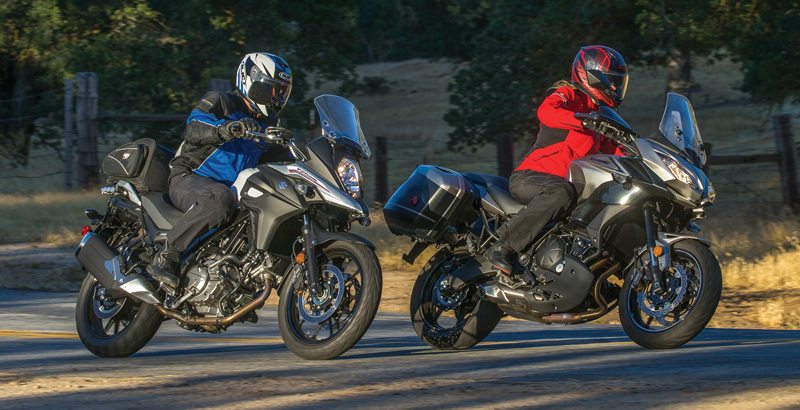
In his Rider Test of the 2017 V-Strom 650, Rider’s Senior Editor Drevenstedt mentions The Question: “If you could only own one motorcycle, what would it be?” After the requisite moaning and gnashing of teeth, for many riders (including some of the Rider staff) the answer comes down to one of these two: the Kawasaki Versys 650 or Suzuki’s V-Strom 650. Inexpensive, versatile and fuel-efficient, they are the Swiss Army knives of the motorcycling world.
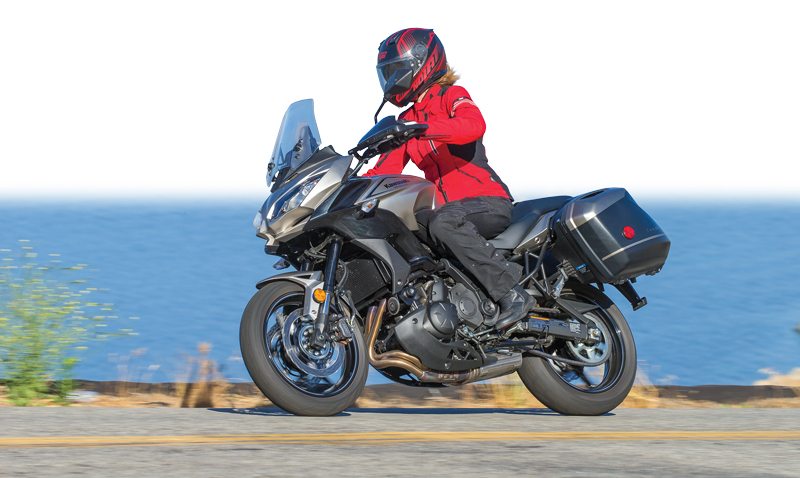
With the V-Strom 650 getting a facelift and updates for 2017, and our last comparison test between the Strom and the Versys having taken place back in November 2012, we figured it’s high time to pit these two do-it-alls against one another in a one-on-one, mano a mano showdown. Given how closely contested the 2012 comparison was, plus the glowing reviews the Versys 650 LT gathered from staffers in 2015, it promised to be an interesting matchup.
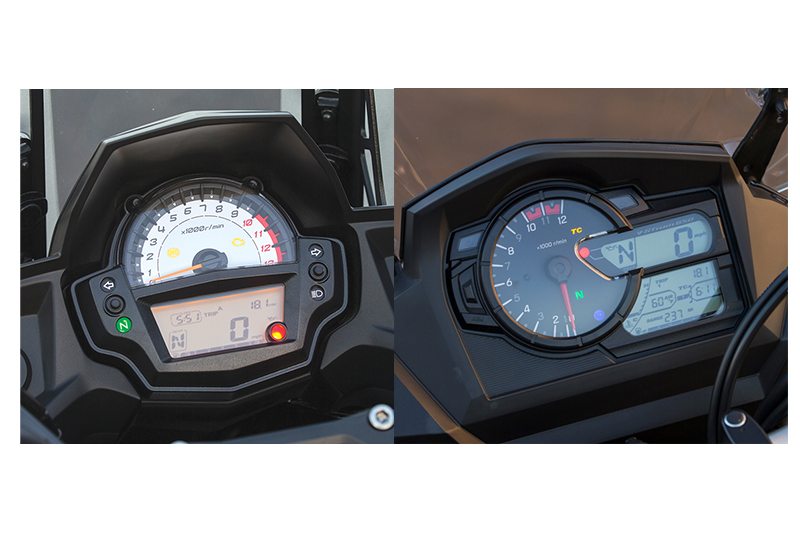
In the first corner, wearing Pearl Glacier White trunks we have the Suzuki V-Strom 650, which seems to be gradually settling further into its role as a bona fide adventure-sport tourer. It was always the more dirt-oriented of the two, with a 19-inch front wheel, 90/10 on-/off-road tires and uncanny balance. For 2017, its rock-solid 645cc V-twin was tweaked for Euro4 compliance and more power, and it has new features like 3-position (two modes plus off) traction control, Easy Start and Low RPM Assist, new optional quick-release hard luggage and a redesign that includes an ADV-style beak.
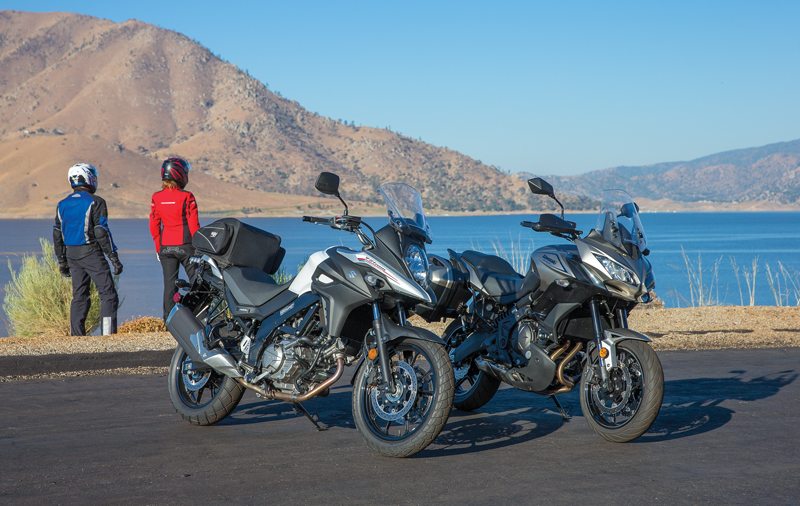
In the second corner, wearing Metallic Flat Raw Titanium trunks we have the Kawasaki Versys 650 LT, which comes standard with color-matched quick-release hard luggage and black hand guards. Arguably the better looking of the two, the Versys is sporty and compact, with street-oriented Dunlop Sportmax-shod 17-inch wheels and a dual-headlight fairing that bears a strong family resemblance to Kawasaki’s Ninja sportbike lineup. Much of the Versys’ compactness can be attributed to its 649cc parallel-twin engine, which remains unchanged from previous models. It’s relatively short on electronic aids and whiz-bang features; there’s no traction control, although the analog tach/LCD display now includes a helpful gear indicator.
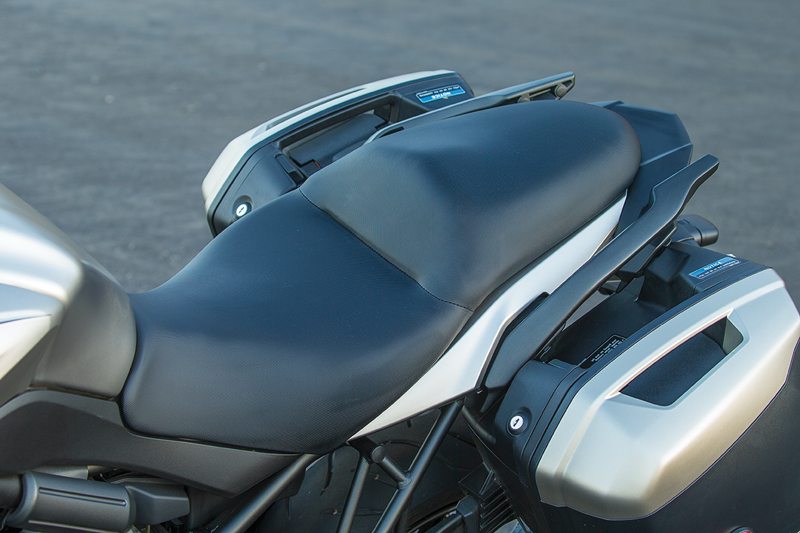
For two bikes that look so different, it’s no surprise that they also feel different from the moment the rider swings a leg over the seat. The V-Strom, thanks to the 90-degree V-twin slung beneath it, feels long and narrow, with a wheelbase that’s more than 5.5 inches longer than the Versys. Although its seat is 0.2 inch lower, it feels more spacious, and the longer reach to the handlebar means smaller riders might feel more comfortable on the Versys—if they can handle its 33.1-inch seat. Speaking of seats, neither bike’s is particularly comfy, with the Suzuki’s being too hard and the Kawi’s too soft. I found that I could more easily live with the Strom’s, however, since the Versys cants the rider forward with no support, making me feel like I was perpetually rolling forward on my pelvis.
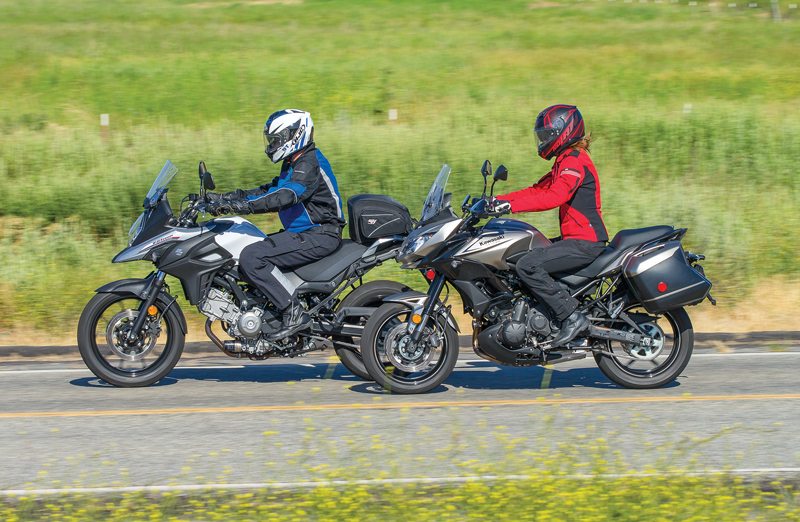
Both the Versys and V-Strom have remote preload adjuster knobs for the rear shock, a real convenience especially when loaded with side luggage. The Versys’ fork features preload and rebound damping adjustment but preload only at the rear, while the V-Strom is the opposite, with preload only on the fork and rebound and preload at the rear. Neither bike’s suspension could be called “great,” and considering their modest power output they’re probably at their best on one-up touring rides anyway. That said, Drevenstedt remarked that the V-Strom maintained its composure even at his…”spirited”…pace, and EIC Tuttle was pleased to find that the rear shock on the Versys had enough preload to comfortably handle him and his wife on a two-up day ride.
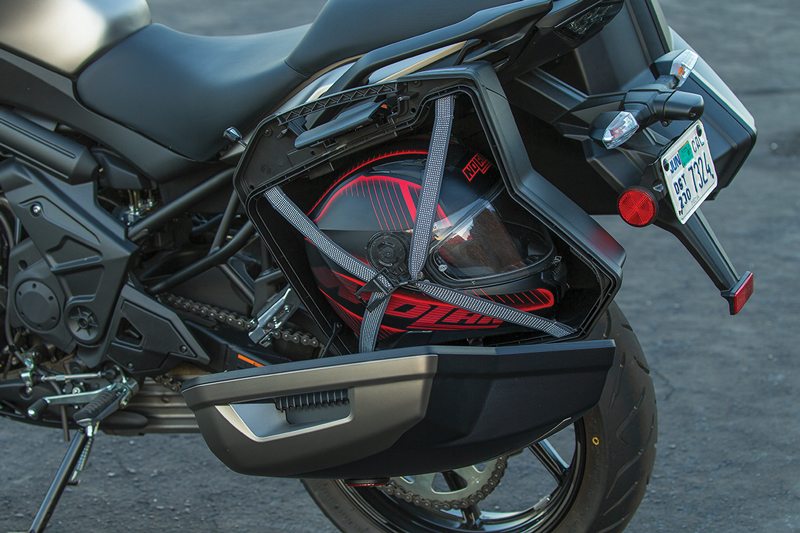
As we droned north along Interstate 5 on our way to the deliciously twisty Caliente-Bodfish Road near Lake Isabella, California, each bike’s road-going personality became clear. The Versys needs some prodding to keep up with the typical SoCal lead-foot freeway traffic, and the resulting buzz from its parallel twin is tamed somewhat by the rubber-clad footpegs and large bar end weights. Meanwhile the Strom holds both a power and torque advantage, besting the Versys’ 61.2 peak horsepower at 8,300 rpm with 68.7 at 9,100 on the Jett Tuning dyno, and reaching its 44.2 lb-ft peak at 6,500 rpm compared to the Kawi’s 42 lb-ft peak at 7,300. Its V-twin is smooth, full of character and sounds great, although at higher speeds (around 80 or so), some vibes creep into the grips.
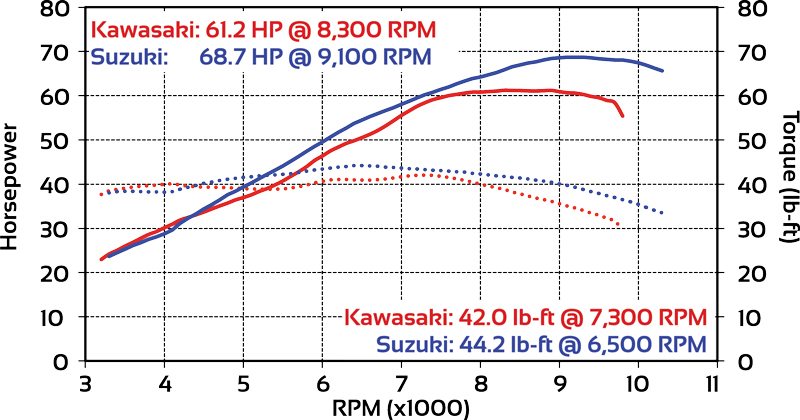
Wind protection on both bikes is adequate, with the V-Strom’s wider windscreen creating less buffeting around the rider’s head but allowing more air in around the torso, and the Versys’ toolless screen being easier to adjust and providing better torso protection at the expense of more head buffeting. While we weren’t able to get Suzuki’s optional quick-release luggage for the V-Strom in time for the test, we can say that the Versys’ luggage is one of the most well designed, easy to use systems out there. Our only complaint was that the plastic internal strap fasteners aren’t as robust as we’d like; one broke on day two of our test.
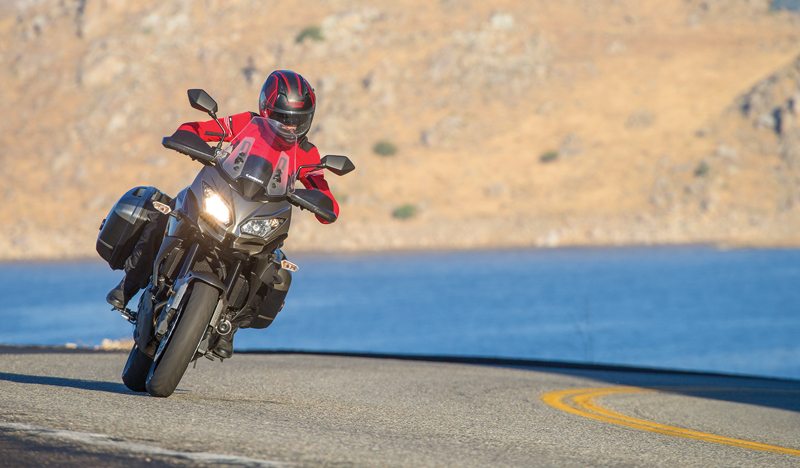
It was when we exited the Interstate and hit the twisties that a clear winner began to emerge. On the Versys, the rider is forced to juggle the smooth, gentle inputs required of a grabby clutch and an abrupt open/closed throttle response with wheezy mid-range power that demands plenty of wrist twisting. It’s also challenging to balance the compact Versys’ flickability with its tendency to fight the rider when ridden hard, as it wants to stand up under heavy braking into corners. Meanwhile the V-Strom, with its baked-in user friendliness, is a willing and confident mount. Everything about it is reassuring and easy, from the positive gearbox to the smooth clutch and throttle. Mid-corner corrections? No problem. And if the rear end decides to come loose, the traction control is there to step in. Should you find yourself staring down a gravel or rocky dirt road, the Bridgestone Battlax Trail Wing tires, 19-inch front wheel, long wheelbase, low center of gravity and decent suspension travel (5.9 inches at the front, 6.3 inches at the rear) make the V-Strom a capable adventurer.
Neither bike is perfect; both have suspension and brakes that are “OK,” and neither one comes with a centerstand. Electronics and rider aids are basic—heated grips are optional on both and cruise control isn’t available at all. But these are Swiss Army knives, built to be attractive in both price and utility. And if we had to choose one—and only one—the adventure-ready, canyon-carving, freeway-flying, fuel-sipping 2017 V-Strom 650 would be it.
Jenny’s Gear
Helmet: Nolan N84
Jacket: iXS Finja
Pants: Joe Rocket Alter Ego
Boots: Tour Master Trinity
2017 Kawasaki Versys 650 LT Specs
Base Price: $8,999
Warranty: 2 yr. limited warranty
Website: kawasaki.com
ENGINE
Type: Liquid-cooled, transverse parallel-twin
Displacement: 649cc
Bore x Stroke: 83.0 x 60.0mm
Compression Ratio: 10.8:1
Valve Train: DOHC, 4 valves per cyl.
Valve Insp. Interval: 15,000 miles
Fuel Delivery: DFI w/ 38mm throttle bodies x 2
Lubrication System: Wet sump, 2.4-qt. cap.
Transmission: 6-speed, cable-actuated wet clutch & Positive Neutral Finder
Final Drive: O-ring chain
ELECTRICAL
Ignition: TCBI w/ digital advance
Charging Output: 372 watts max.
Battery: 12V 12AH
CHASSIS
Frame: High-tensile steel trellis frame, steel gullwing swingarm
Wheelbase: 55.7 in.
Rake/Trail: 25 degrees/4.3 in.
Seat Height: 33.1 in.
Suspension, Front: 41mm USD fork, adj. rebound & preload, 5.9-in. travel
Rear: Horizontal back-link shock, adj. preload (remote), 5.7-in. travel
Brakes, Front: Dual 300mm petal-type discs w/ 2-piston calipers & ABS
Rear: Single 250mm petal-type disc w/ 1-piston caliper & ABS
Wheels, Front: Cast, 3.50 x 17
Rear: Cast, 5.0 x 17
Tires, Front: 120/70-R17
Rear: 160/60-R17
Wet Weight: 496 lbs.
Load Capacity: 443 lbs.
GVWR: 939 lbs.
PERFORMANCE
Fuel Capacity: 5.5 gals., last 1.0 gal. warning light on
MPG: 87 PON min. (low/avg/high) 40.5/51.3/56.0
Estimated Range: 282 miles
Indicated RPM at 60 MPH: 4,500
2017 Suzuki V-Strom 650 Specs
Base Price: $8,799
Warranty: 1 yr., unltd. miles
Website: suzukicycles.com
ENGINE
Type: Liquid-cooled, transverse 90-degree V-twin
Displacement: 645cc
Bore x Stroke: 81.0 x 62.6mm
Compression Ratio: 11.2:1
Valve Train: DOHC, 4 valves per cyl.
Valve Insp. Interval: 14,500 miles
Fuel Delivery: DFI w/ SDTV & 39mm throttle bodies x 2
Lubrication System: Wet sump, 2.7-qt. cap.
Transmission: 6-speed, cable-actuated wet clutch
Final Drive: O-ring chain
ELECTRICAL
Ignition: Electronic
Charging Output: 390 watts max.
Battery: 12V 10AH
CHASSIS
Frame: Cast aluminum twin-spar, cast aluminum swingarm
Wheelbase: 61.4 in.
Rake/Trail: 25.3 degrees/4.3 in.
Seat Height: 32.9 in.
Suspension, Front: 43mm stanchions, adj. preload, 5.9-in. travel
Rear: Single link-type shock, adj. rebound & preload (remote), 6.3-in. travel
Brakes, Front: Dual 310mm discs w/ 2-piston calipers & ABS
Rear: Single 260mm disc w/ 1-piston caliper & ABS
Wheels, Front: Cast, 2.50 x 19 in.
Rear: Cast, 4.00 x 17 in.
Tires, Front: 110/80-R19
Rear: 150/70-R17
Wet Weight: 467 lbs.
Load Capacity: 448 lbs.
GVWR: 915 lbs.
PERFORMANCE
Fuel Capacity: 5.3 gals., last 1.1 gals. warning light on
MPG: 87 PON min. (low/avg/high) 41.0/46.9/58.5
Estimated Range: 248 miles
Indicated RPM at 60 MPH: 4,400

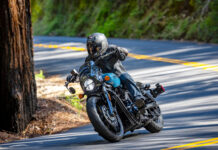






The suspension and brakes on the V-Strom are just “ok”!!! If it weren’t the truth, I’d consider that both condemnation with faint praise and blasphemy.
Over the last 50 years I’ve ridden and owned many bikes, including three new V-Stroms. My present ’15 ‘Strom sits beside my beloved ’09 VFR, but it gets three times the use of the Honda. The Wee’s a great bike that feels like comfy slippers every time I put my ass on it. Mixed metaphors aside, the only thing I’d love Suzuki to consider is to market a fully jazzed up ‘Strom ( i.e.: excellent brakes, wheels, tires and suspension) for a few thousand dollars more than the base model. Toss in the new “VVT” system they’ve patented and I’d be pathetically quick to make it my fourth ‘Strom.
I have owned my 2016 650LT for over a year. Your description does not even come close to my experiences on this bike. I have owned 26 bikes and ridden more than a million Smiles on those bikes. I feel that the torque,and handling are terrific on the san diego back roads that I travel.
I agree 100%
Seems odd that your dyno numbers are different on the versys compared to everything else I have read.
Actually, your entire article seems very suzuki centric. A bit biased, even by how it’s written.
We can’t speak to others’ Dyno figures, but we use Jett Tuning exclusively for all our Dyno tests, to try to maintain consistency. That said, the smallest things like humidity, altitude, ambient temperature and even tires can have an effect on the results. We tested the Suzuki and the Kawi back-to-back, and the numbers don’t lie. As for the review being “Suzuki centric,” that may just be because the V-Strom was my pick (which, incidentally, was backed up by both Senior Editor Drevenstedt and Editor-in-Chief Tuttle). You may prefer the Versys, and that’s okay. But a comparison test will always involve some subjectivity and opinion, and for me the Strom was the better bike. I hope you don’t hold that against me! 🙂
I suppose that makes sense.
I personally haven’t rode either yet, but I am planning on buying , likely, one of those two in the next year. I had to sell my old bike due to a cross country move, Suzuki Boulevard C50.
Much of your experience actually just contradict the majority of reviews of the bikes that I have read. For instance, the versys has always come out ahead on the handling.
Either way, all information it good when doing research, but in the end it’s all about the ride.
Impressive indeed, new Suz made lost 7hp to the Versys. Strange enough.
I owned a first gen versys for over 5 years. I found its back roads and twisty handling very good. The suspension is overly stiff and harsh. But the motor did not feel Wheezy at all .It had a pretty good mid-range Rush.mpgs avg 45 to 55. Front brake was decent rear brake terrible.
40k miles on my Verysy and I say ditto to Randy
Another disgruntled 2015 Versys 650 owner here 😉 Most of the rest of the motorcycling mag world seems to say there is no comparison between the Versys and the Strom. Versys being the better by far. Surprising review.
All those other reviews are not of the new 2017 V-Strom. I have the 2015 Versys and I feel this article is spot on. I installed a Power Commander V recently, and now the Throttle Tamer is on order. Hoping to settle down this jumpy, over-sensitive throttle. The 2017 V-Strom may be what I need.
Seems as the VStorm has improved a lot since 2015. Everything I read on the 2015 models gave Kawi an advantage in most every category. What about 2016 models. Which of the two would take best bike head to head.
As another Versys owner, I have to agree the versys has abrupt throttle though, and the lack of traction control is galling (even if I’d probably only need it in the wet).
Having previously read your review of the Versys, this article seems to be written buy the Suzuki press department.
This is a line from your previous article about the Versys; ” the 650 dances down twisting roads with intuitive ease, the tighter the turns, the better.”
I have no particular favorite between the bikes, just think you should review previous articles on a you have written on a bike your are reviewing and find comments like “wheezy mid-range power” to be inappropriate for a magazine such as Rider. You are one of only two motorcycle magazines I subscribe to ( I don’t count the AMA mag) but should the articles continue like this one, I will drop Rider.
Have owned a 2007 Vstrom since new and while briefly considering the then new 2008 Versys, they were miles apart. An inadequate dinner-plate sized windshield and narrow dirt-bike sized seat on the Versys immediately cancelled that possibility. However these two bikes have come closer together, each picking up clues and improvements from the other. So while each is refreshed every few years, the reviews always biasly favour the “new” model for that year. If I were to update my ride, it would likely be a new Vstrom as I couldn’t be happier with it, but I would still compare it against the Versys, just to be sure I get what I want. And of course, that always means a demo ride.
Being in the market for a solo riding, do it all bike, I went out and test rode both a 2017 Versys LT and 2017 V-Strom ABS one day apart. Being a 8x Kawasaki owner, I really wanted to like the Versys better, but it wasn’t to be. I pretty mucg came to the same conclusion as the Rider editors.
Ergo’s: Being 6’3″/35″ inseam, I found the V-Strom triangle more conforming. I’ll need peg lowering mounts regardless of pick. I found the V-Strom seat more to my liking as the Versys had the dreaded slope (cheap/easy fix). I was happy with both bike’s wind protection.
Power/Tranny: The Suzuki did have a bit more zip and a MUCH smoother shifting transmission. Throttle response was smoother on the V-Strom also (this coming from a current FZ09 owner who knows).
Ride: The Versys was the sportier of the two for me but the ride quality of the Strom was noticeably better with the longer wheel base. This bike will be much better on inter-state roads.
The luggage on the LT was very convenient. I’d opt for the standard Versys and fit my own luggage anyways.
For a 60 year old, 100% solo rider, I will have a new V-Strom in the garage this riding season. For street pricing of < $10k, I can equip this bike with full detaching luggage, comfort bits (peg lowering/heated grips/hand guards/mirror ext) and a McCruise cruise control unit. Sounds good to me 🙂
For me, the hands-down winner is the Suzuki. Better engine and optional center stand is all I need to know.
But that’s just me.
I’ve owned Kawasaki and Suzuki motorcycles over the years and find them both a joy to ride. One point I noticed in your article is the price-point in comparison to what you get. The Versus 650 LT comes with hand guards and side bags for the price you mentioned. However, according to Suzuki’s website that you reference, the V Strom 650 does not come with either hand guards or side cases. That appears to be about another $800 to man Match the equipment offering on the verses.
Pardon the typos! That’s what I get for using dictation 🙂 ….
My last sentence meant to read: That appears to be about another $800 to match the equipment offering on the Versys.
Suzuki all the way. Full stop
he tenido la oportunidad de manejar ambas motos, y la verdad las dos son excelentes, el punto principal considero es: ¿que busca el conductor? y las características del mismo, si lo que buscas es deportividad, esa sensación lo da la Kawasaki, si buscas confort y viajes largos, la susuki es la ganadora en este terreno, la talla del piloto también cuenta, simides mas de 6 pies, agradecerás a la susuki que piense en pilotos de tu talla, si mides 5.5 pies la kawasaki te recibirá gustosa, yo en lo personal escogería la Susuki, ya que es mas el manejo que busco (tengo una triumph tiger sport 1050 y una KTM 1290 super adventure S, dos máquinas muy diferentes) pero ya no busco poner la rodilla en el suelo, ni quiero llevar las motos a su límite, por eso siento que la susuki sería mi elección, tambien les menciono que tengo 53 años de edad, es posible que eso tambien me haga inclinarme mas por la susuki, posiblemente di fuers un par de décadas menos podría elegir la kawasaki por las emociones que produce, creo que las 2 motos son excelentes, lo importante es saber bien que buscamos en nuestras motos y modos de conducción.
y recuerden, no hay moto mala, pero si hay mala elección de moto, es a eso a lo que me refiero cuando digo, hay que saber que buscamos en nuestra moto
saludos y excelente reportaje, de hecho creo que falta mencionar que si eres un motociclista principiante en mediana cilindrada, la susuki es una moto mas fácil de manejar que la kawaski para quien empieza, ya con experiencia ambas son geniales
saludos a todos
The reality to me is that most people would be happy with whichever bike they chose. Both are great bikes. I have a 2013 V Strom but that was my choice and may not be yours. A biking buddy of mine also had a 2013 V Strom 650, and after that bike was totaled when someone rear ended him, he bought a Versys 650. He liked his V Strom 650 but liked his newer Versys even better. He recently traded the Versys for the third generation V Strom which he likes even better. But those are his choices. A few years back I had decided that I wanted a FJR1300 based on the reviews. However, after test riding both bikes I found a Honda ST1300 was the bike for me. I learned then that the reviews were helpful for some information, but that the final decision would be the bike that worked best for me. I could happily have a Versys, as it’s a great bike as well. Let’s go ride…..
So far I’ve owned a 2008 Bonnie T100, a Triumph Tiger 800 (roadie) and a Vulcan S. The first and last bike didn’t do it for me. They were sweet, but the T100 made me uncomfortable and didn’t inspire confidence, while the Vulcan S is a hooligan bike and a lot of fun, but sadly the cruiser position doesn’t do well for my back and arse. The Tiger? That was an awesome bike, but after five years I just wanted something else, so I traded it for the Vulcan. In retrospect I do miss that bike, it was sweet as hell for my size, even though the suitcases are made of solid lead and not too roomy.
So to get rid of the Vulcan S I started looking at the V-strom 650 and Versys again. To my mind, the seat on the V-strom was a bit to wide for my ass. Yes, it was roomy, and yes, the Versys pitches you forward, but all in all the ergonomics of the Versys fit me better at 1.85m tall and 92kg. Both machines place the pegs where my calf is when I put a foot down though. 🙂
Then the riding experience was quite different. The V-strom is very capable, steady and linear in it’s delivery of power. On the “Snelweg”, I guess the equivalent of an interstate, it is stable and quiet. On twisty roads the Versys is a potential hooligan bike again. It’s just that much more flickable, and the fact that it’s rev happy like my Vulcan is a bunch of fun. In short: The V-strom is arguably the better commuter bike, while the Versys just puts a bigger smile on my face. By the way, the 2019 Versys has 69 bhp and 64Nm torque, so 2 bhp less than the Suzuki, but 3Nm more torque.
I finally went for the Versys, told my dealer to slap a Givi (not Kawa, twice the price) top case on it, a couple of Puig crash guards, the Kawa hand guards and a USB port for my RAM-mounted phone. Also I told ‘m to ditch the stock D222 tires and slap a pair of Pirelli Scorpion Trail II tires on it.
Given the tire upgrade, I think this set-up will do fine on fire roads and packed gravel. I intend to put that to the test in Scotland coming spring, so we shall see. The bike for me was the Versys, although the Strom is a clean competitor.
Once the Yamaha Tenere 700 is a couple years old, though, I think that bike might actually be the end-all-be-all option. It’s just that the 3000 Euro price difference was too rich for my blood, but my oh my, Yamaha has raised the stakes somewhat this fall.
Well, Versys 2015 has according Kawasaki in official technical book about 68 HP, so I found this comparation with Suzuki V-Strom somehow “weird”, as your Versys in the test is somehow “not fit as it should be”. What about this findings saying Kawasaki distributors? *** Both bikes are great, btw. 🙂
Manufacturers typically quote peak horsepower at the crank, not measured at the rear wheel. We strive to be as fair as possible in our Dyno tests, always using the same one at Jett Tuning and testing the bikes back-to-back as often as we can to negate potential temperature and barometric pressure differences. And yes, both bikes ARE great, I just happened to like the ‘Strom better. 🙂
Jenny Smith, no soup for you!!!
I have owned a few bikes over the years , V-Strom 650,Transalp,Bandit, Honda Deauville, 2xMK1 Versys etc etc and my 2017 650 GT is by far the best bike i have owned….taken me to Europe a few times and all over the UK loaded with camping gear …it never asks for anything its perfect power for me and comfy as hell …quite simply a grade A product from the versys range from previous models.
I do also have a mixed feelings about this article too. I’d agree that both bikes are nice however, from this publication I’d rather expect more of an unbiased comparison. It’s perfectly fine to say that one of those two bikes is better but it’s just based on a personal perception of the writer and it doesn’t really help the reader to draw his own conclusion. I’ve ridden both V-Storm and Versys in my life and I have the impression that they are still very different bikes and there is a lot bigger focus on Suzuki in the text, without really presenting Kawasaki’s strong aspects. I hope that you’re open for a constructive feedback guys, since this kind of comparison has a big potential for the future!
PS mentioning that someone owns Kawasaki and that’s the reason she/he is disappointed with the text is just weak.
How do you as much hp/torque on your dyne as Suzuki claims at the crankshaft. Every other dyne run shows a V-Strom 650 as having about 52 hp at the rear wheel. Are your numbers converted into crankshaft readings.
We double-checked the numbers and they are correct and comparable to dyno tests published by other magazines.
My bad.
A lot of internet tough guys say you cannot compare different Dynomometer runs on different days but don’ they “normalize” the results to a standard temperature and pressure? Even if they don’t apart from my mistake here, I rarely see different Dyno runs indicate more than a 3% difference in peak torque or peak hp but the torque curves and hp curves are always nearly the same.
The point being that I have zero trouble comparing different dyno runs if that is all I have available. If one test has an Africa Twin 1100 dynoed and I want to compare it to the V-Storm 1050, I am comfortable comparing different dyno’s on different days as I don’t see much difference other than that 3% or so I mention above. If two dynos are only off by that amount I can still compare dyno to dyno to see which bike has a power curve I would prefer.
I am curious what your thoughts are about strictly comparing back to back dyno runs vs different runs on different days to get a ballpark figure on an engine’s output.
Thanks.